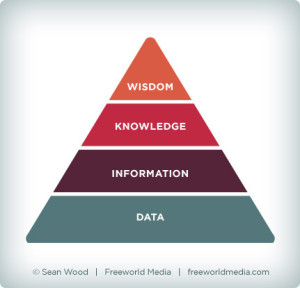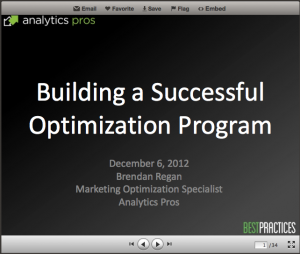Non-profit web analytics success?!? I know, I know. You think I’ve gone crazy with the heat. But today, I’m talking about how web analytics can set you up for success, even if your tax status is a bit different.
Sarah from Seattle tweeted the other week, asking for advice on how to use web analytics, and specifically “goals tracking” to help her with a nonprofit website supporting the Burke Museum of Natural History and Culture. I thought it would be good topic to explore a bit, so I’ll start with the basics.
Even the most “nonprofit” website still has digital goals, and let’s face it, they’re still “business” goals. Keeping that in mind, I’m going to try to label some different types of business goals one could track in web analytics, and more importantly, how to measure success.
- Memberships & Donations – I won’t spend much time on this one because it’s pretty obvious. Most nonprofits’ main digital goal is to solicit memberships or donations. And tracking them using web analytics is no different than ‘for profit’ sites. The only caveat is that (unfortunately) human nature seems to dictate a longer consideration cycle for donations than, say, buying a fancy new smartphone. Knowing this, it’s wise to track the content and micro-conversions that might lead to a donation (micro-conversions). Think about downloading brochures and visiting particular pages about the mission statement, leadership, whether donations are tax-deductible, etc.
- Logistics – For physical spaces like galleries, museums, and parks, there are goals related to logistics that indicate a strong likelihood of a visit. These should be tracked as goals, and optimized on an ongoing basis. Some examples here are downloading a map, visiting a page that lists directions and hours of operation, or even interacting with content related to “events.” For maps, it would be great to track that a visitor had mapped from their location to the nonprofit’s location, as that indicates strong intent to actually visit. For events, some sort of “add to calendar” micro-conversion would indicate strong intent. Another great goal to track regarding events is getting prospects to sign up for time-sensitive reminders via email or SMS.
- Opting In to Content Pushes – That’s an odd phrase, but it’s my way of saying that nonprofits should be tracking goals where prospects allow you into their lives a bit. Anytime a prospect opts to become more than an anonymous site lurker you achieve a portion of your business goal! The Burke Museum has lots of great options already, so it would just be a matter of tracking goals related to: subscribing to their blog, signing up for their email newsletter, taking action to follow them on Twitter, and taking action to friend them on Facebook. If you can’t track with 100% certainty that a conversion has occurred, track the action taken (e.g. clicking a Facebook icon) that shows strong intent.
Note that most web analytics programs won’t necessarily allow you to track all of these things as goals “out of the box,” but with some technical knowledge (especially JavaScript), perseverance, and creativity, they’re all quite achievable.
Calling all NPOs! What else are you tracking (or wishing you could track) as goals in your web analytics?
[A version of this post was originally published July 29th, 2009 on GrokDotCom.com, an award-winning, but now defunct, Marketing Optimization blog.]
 As a practitioner of Web Analytics and Optimization, I’ve spent a fair amount of the last seven years of my career focused on tracking and improving Conversion Rates.This is a noble pursuit for any business, but intense focus on the conversion rate metric can have negative implications – people in your organization (or your clients) may obsess about changes in conversion rate, pester you about them, and even blame you for them!
As a practitioner of Web Analytics and Optimization, I’ve spent a fair amount of the last seven years of my career focused on tracking and improving Conversion Rates.This is a noble pursuit for any business, but intense focus on the conversion rate metric can have negative implications – people in your organization (or your clients) may obsess about changes in conversion rate, pester you about them, and even blame you for them!
 A lunchtime topic came up today regarding Web Analysts and Conversion Optimization specialists. We started debating what each job was all about, what the similarities were, what the differences were, and whether you could be good at both.
A lunchtime topic came up today regarding Web Analysts and Conversion Optimization specialists. We started debating what each job was all about, what the similarities were, what the differences were, and whether you could be good at both.
 I’m going to answer both in this post as I lay out a basic framework for how to “do” web analytics in the context of Optimization. I compare web data analysis to looking with different “lenses” at the same set of data depending on the context. For example, if I’m doing analysis on “site performance,” I would take a different view of the data than if I were doing “campaign analysis” or “content performance analysis.”
I’m going to answer both in this post as I lay out a basic framework for how to “do” web analytics in the context of Optimization. I compare web data analysis to looking with different “lenses” at the same set of data depending on the context. For example, if I’m doing analysis on “site performance,” I would take a different view of the data than if I were doing “campaign analysis” or “content performance analysis.” Is social media a big part of your online marketing strategy? Is it a huge “question mark” in your strategy? Either way, you can benefit from spending some time with some new social reports recently added to Google Analytics.
Is social media a big part of your online marketing strategy? Is it a huge “question mark” in your strategy? Either way, you can benefit from spending some time with some new social reports recently added to Google Analytics.